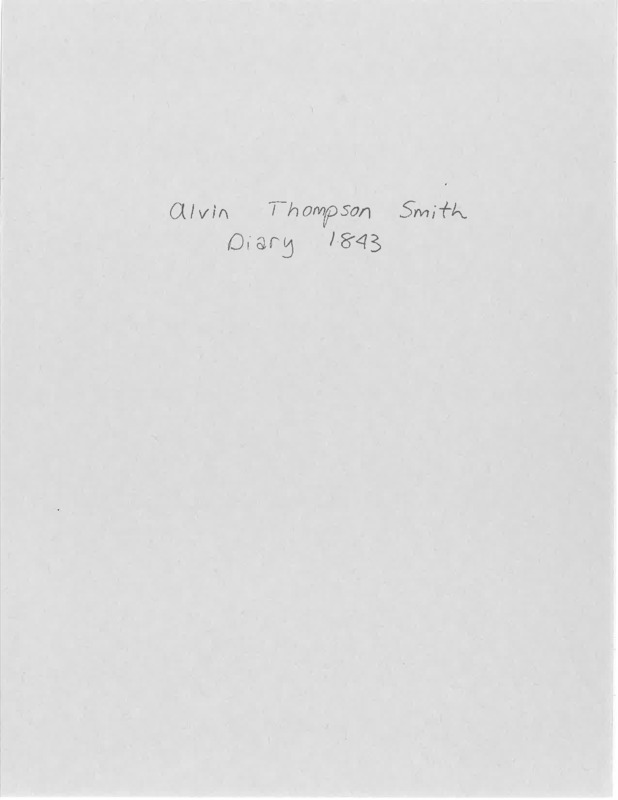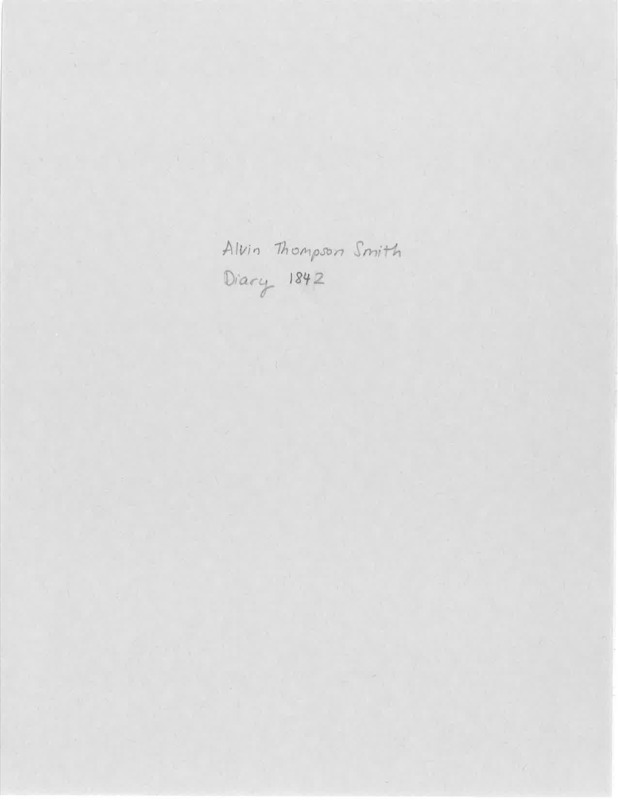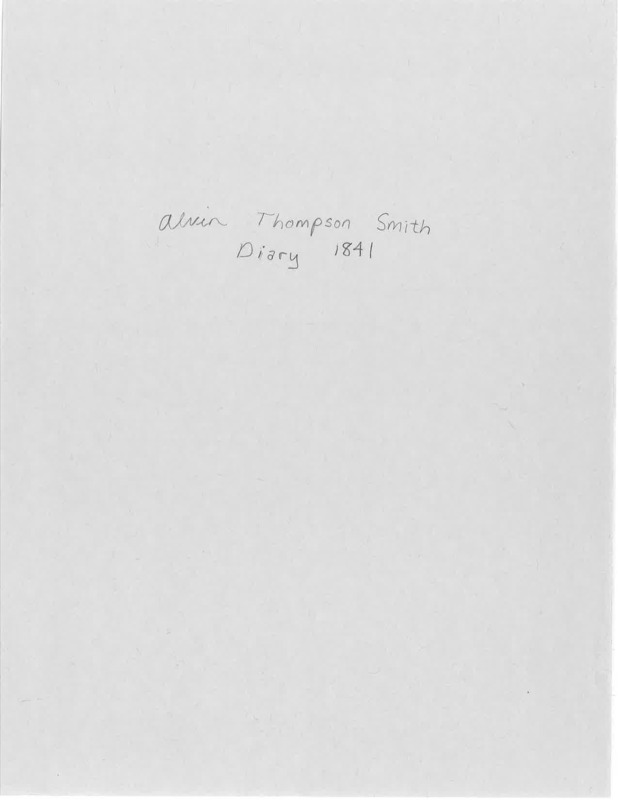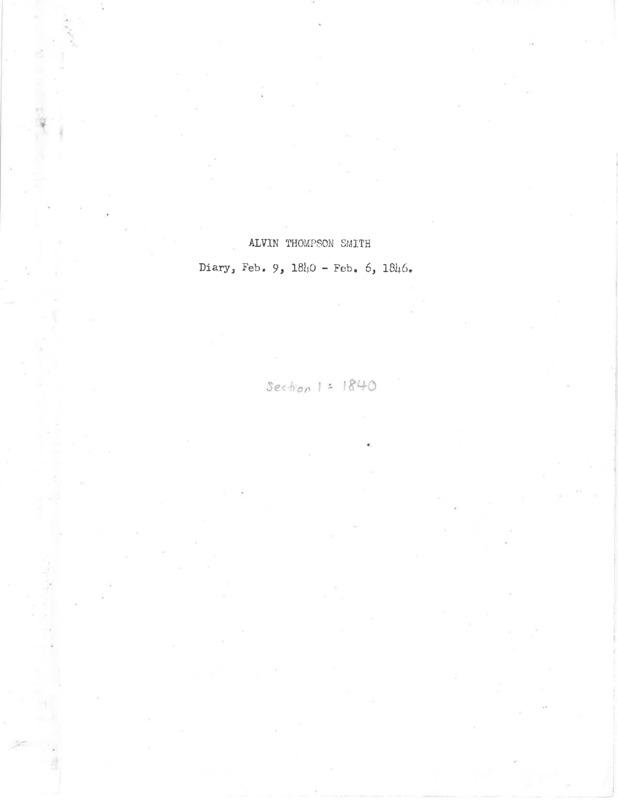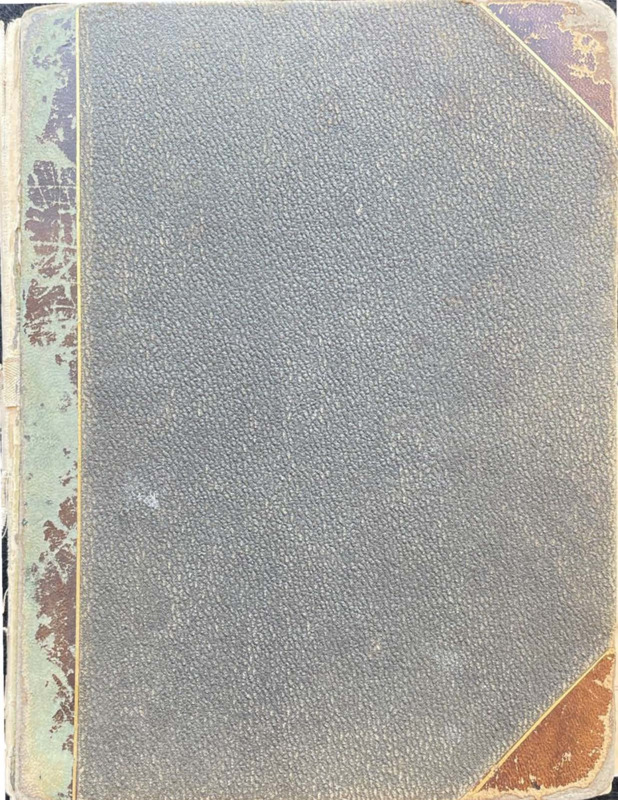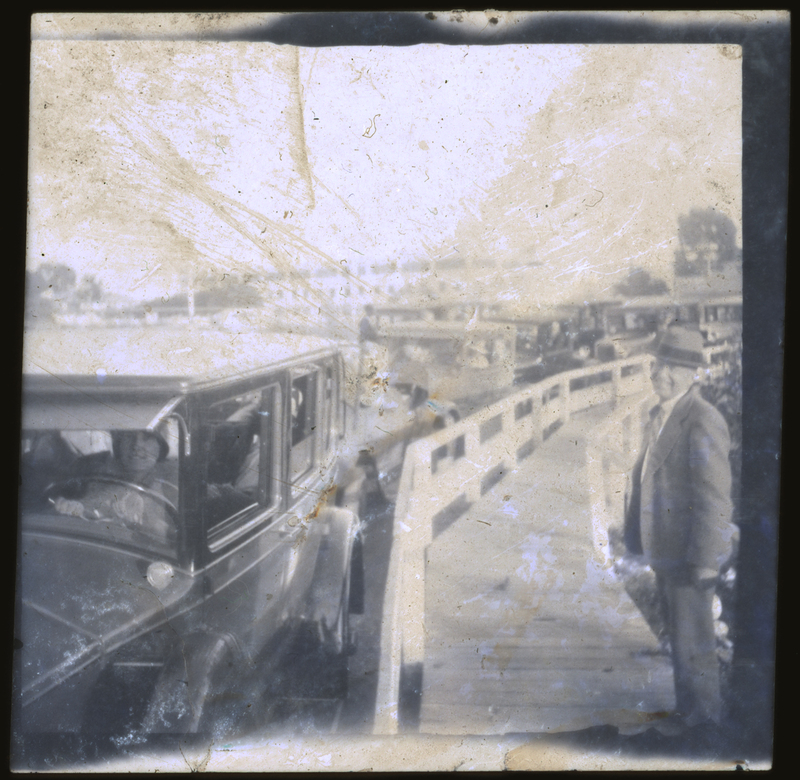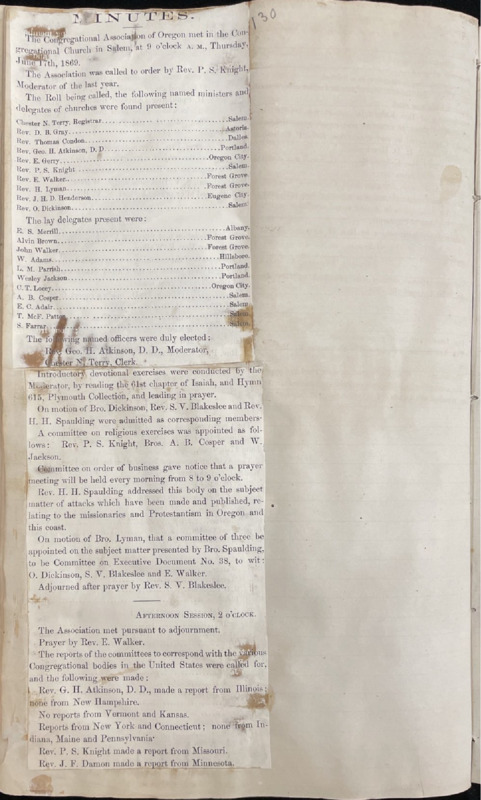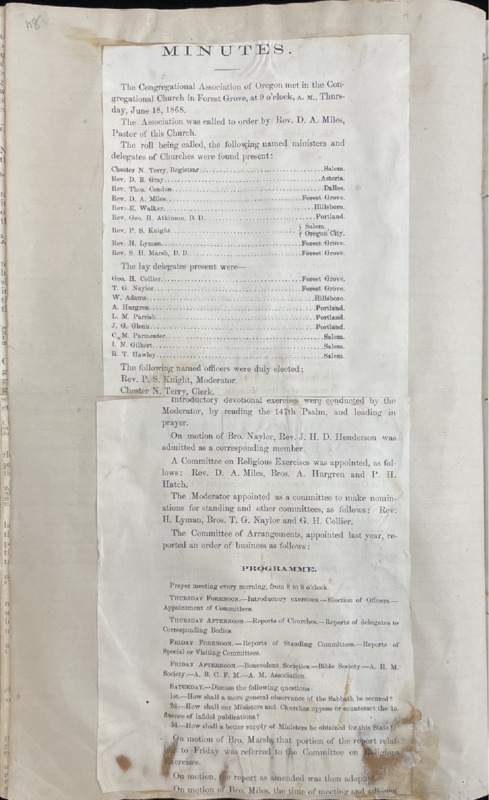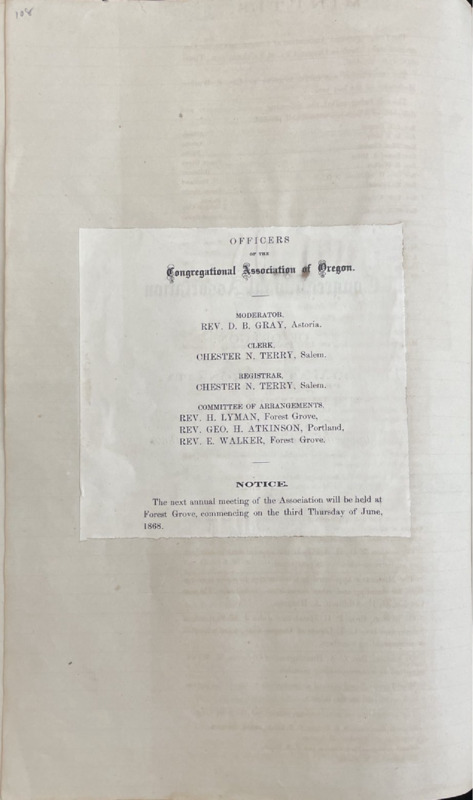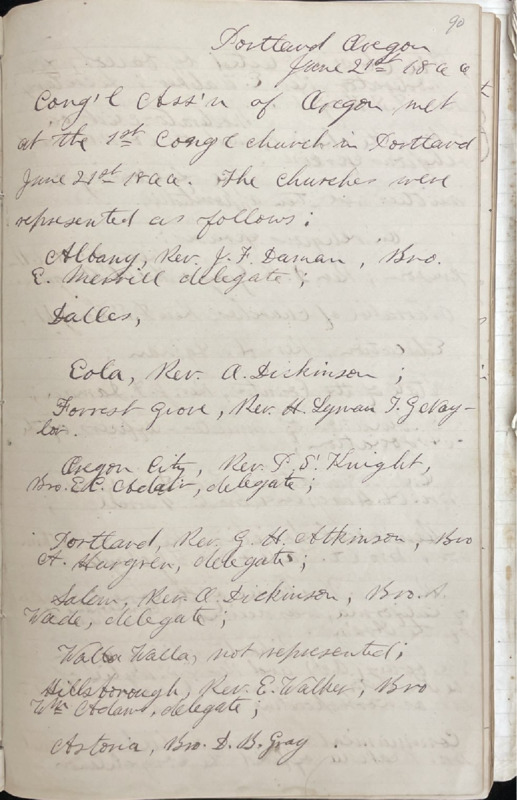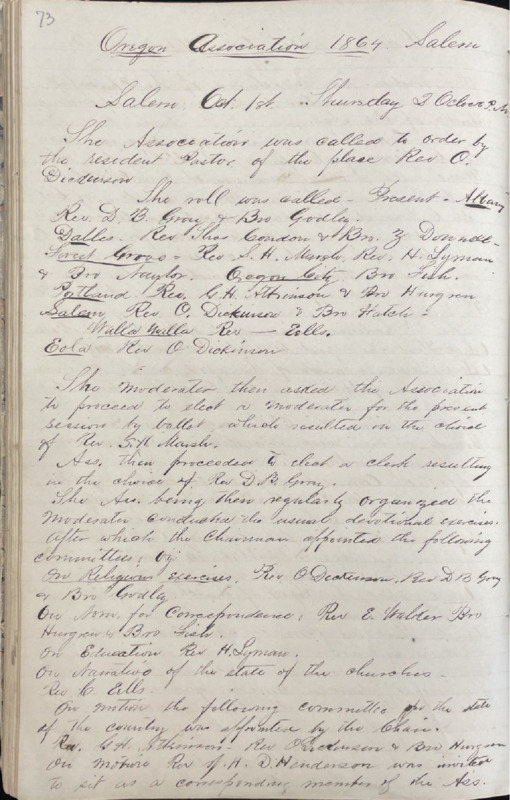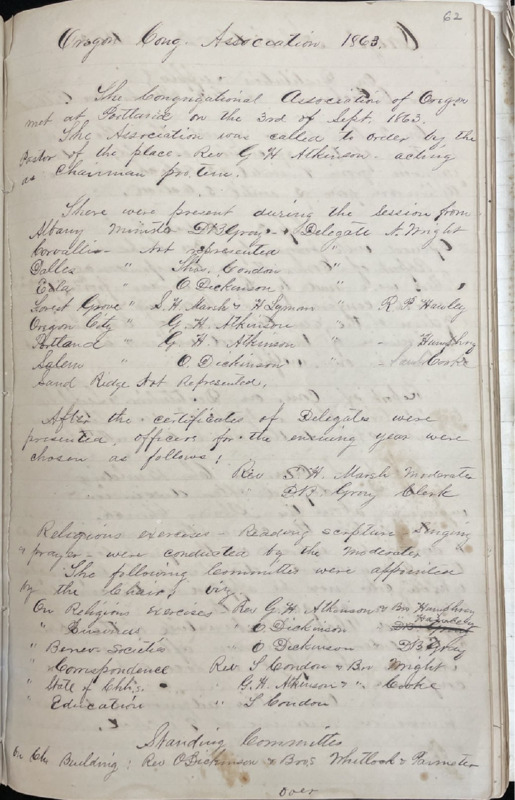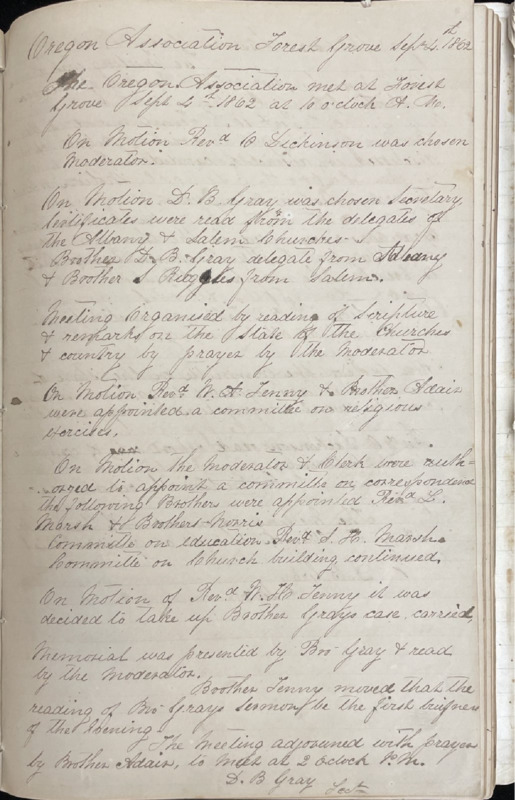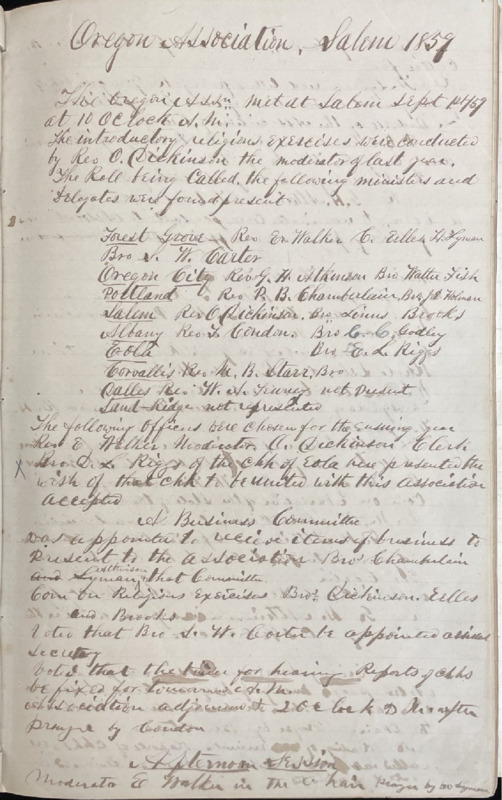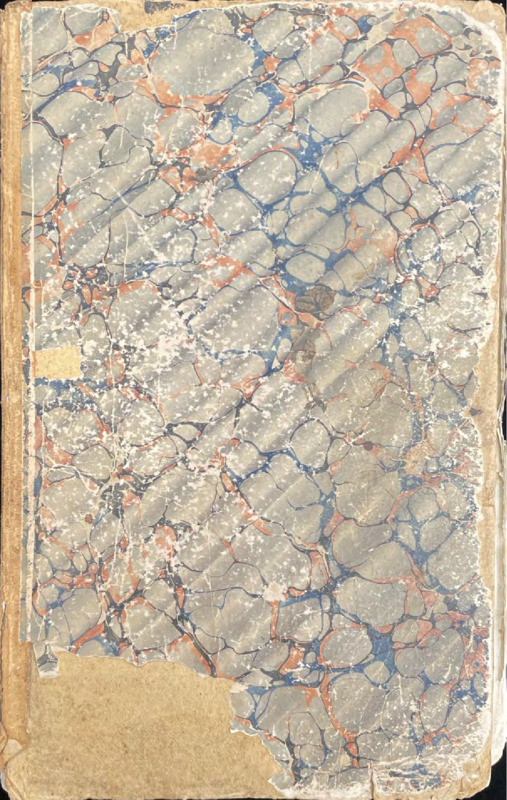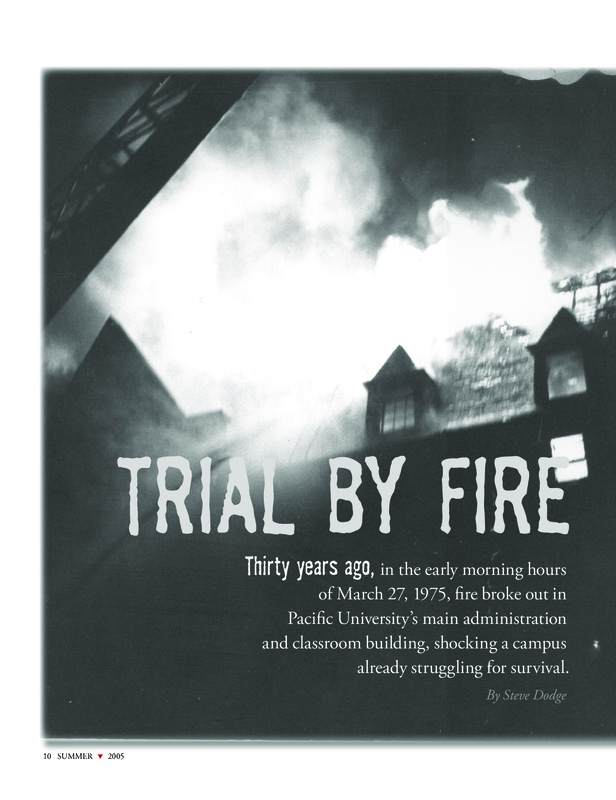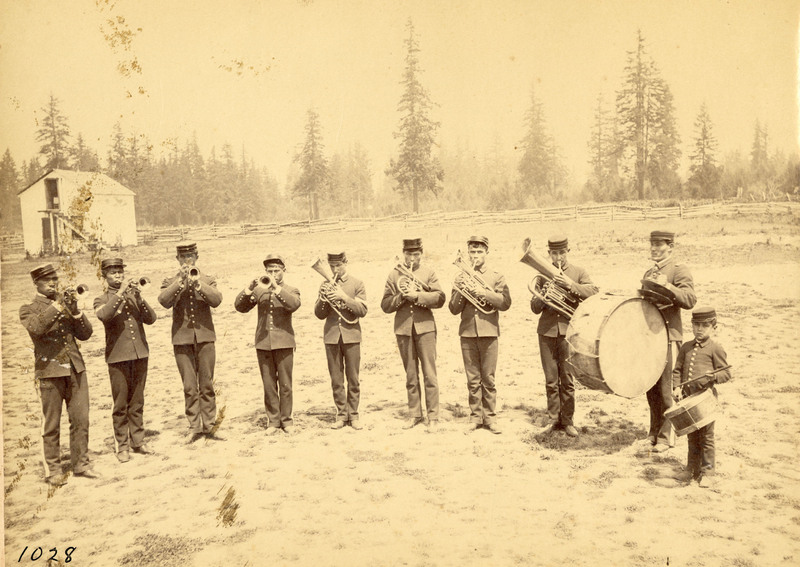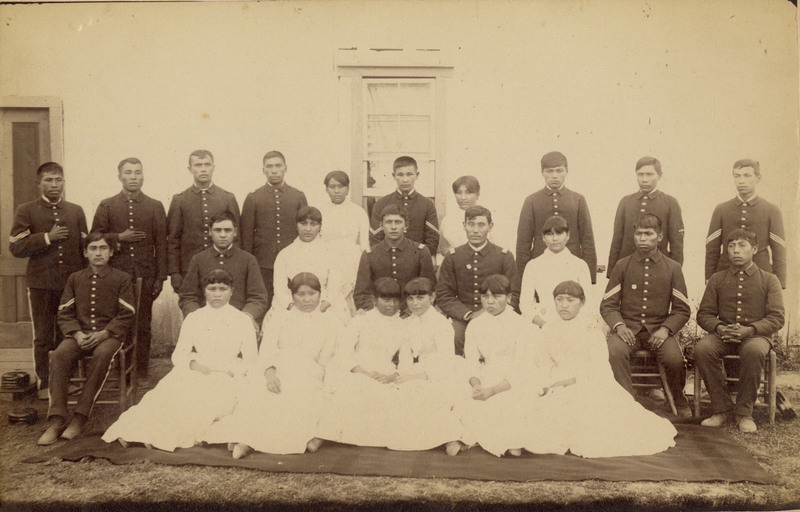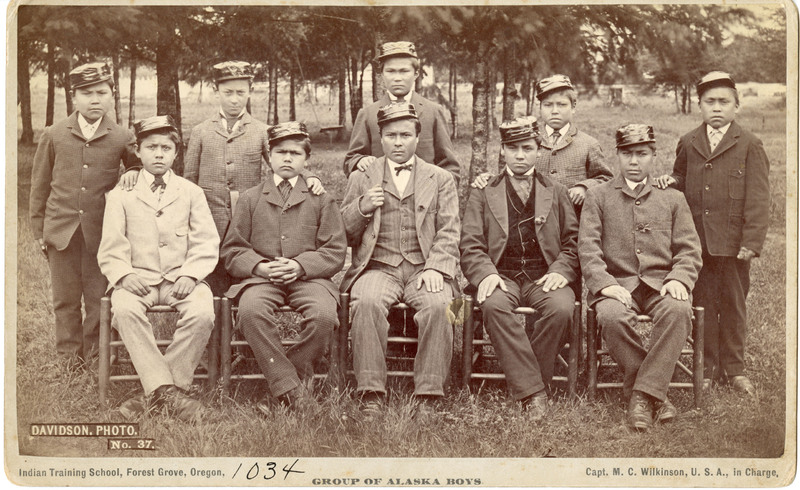Washington County Heritage Online
- Title
- Washington County Heritage Online
Items
-
A. T. Smith Diary transcript 1843A transcription of a 1843 diary in which Alvin Thompson Smith writes about topics such as his daily life living as a settler on the Tualatin Plains, his tending to daily farmwork and chores; constructing a barn; reading and attending prayer meetings and church; his travels to Willamette Falls; Congregational Minister Harvey L. Clark (or Clarke), P.B. Littlejohn, missionary John Smith Griffin, and the business affairs between the men; and his fellow settlers James and David Flet, C. M. Walker, Charles McKay and Cornelius Rogers, amongst others. Smith also describes taking in the children of Joseph Gale.
-
A. T. Smith Diary transcript 1842A transcription of a 1842 diary in which Alvin Thompson Smith writes about topics such as working on the building of his first home on the Tualatin Plains; tending to cattle and pigs and other farmwork; chores of his daily life; reading and attending prayer meetings and church; Congregational Minister Harvey L. Clark (or Clarke), P.B. Littlejohn, missionary John Smith Griffin, and a business dispute between the men; visiting the Willamette River and Vancouver, and his interactions with "Indians" (including a passage describing how he "hunted Indians that had stolen wheat").
-
A. T. Smith Diary transcript 1841A transcription of a 1841 diary in which Alvin Thompson Smith writes about topics such as his daily life at the Spaldings Mission in modern-day Washington; his religious life; working the wheel, loom, and at the lumbermill; his interactions with "Indians;" his traveling company that included Peter B. Littlejohn and Congregational Minister Harvey L. Clark (or Clarke); traveling to Waiilatpu, Walla Walla, and Vancouver; visiting physician Marcus Whitman; some farming; and moving West from the Spalding mission through John Day River and the Willamette River before arriving in an area on the Tualatin Plains that is now modern-day Forest Grove. In the last part of 1841, Smith described how he started working on building a new house for himself and his wife.
-
A. T. Smith Diary transcript 1840A transcription of a 1840 diary in which Alvin Thompson Smith writes about topics such as pondering crossing the Rocky Mountains; living in Quincy, Illinois; the tasks and chores of daily life; his marriage to Abigail Raymond; traveling to Independence, Missouri; repairing his wagon and purchasing mules; interacting with "Indians;" his troubles traveling on the Great Plains with a company that included Congregational Minister Harvey L. Clark (or Clarke); his interactions with buffalo hunters; his passing through of the Black Hills region, Independence Rock, the Columbia River region, and Snake River; prayer and his religious life, and staying at Henry Spalding's Presbyterian mission in modern-day Washington for the winter of 1840-1841.
-
Leabo Family HistoryA family history and genealogical notes on the Leabo Family of Oregon and California, handwritten by Alonzo Reas Leabo in 1936-1938, with some later additions. The Leabo Family is descended from Jacob Leabo (1795-1880), who made his first trip to Oregon in 1847. The Leabos settled in Forest Grove, Oregon in the 1860s, where several family members attended Pacific University. In 1919, many members of the Leabo Family began moving to Monrovia, California, where they lived for much of the 20th century. Alonzo describes the Leabo Family's genealogy as well as many personal details of their lives, including an account of their travels from the East Coast to Oregon in the 1840s-1860s; encounters with Native Americans on the Oregon Trail; the founding of and attendance at Pacific University and Tualatin Academy in Forest Grove; work at Forest Grove businesses including the Hinman, Haines and Bailey stores, the Forest Grove Hotel and the First National Bank of Forest Grove; life and family properties in Portland, McMinnville and St. Joseph, Oregon and in Monrovia, California; and his family members' personalities, interests, health, deaths, and burials. Alonzo provides brief biographies and/or genealogical notes about many family members, including: Great-grandparents: Francis Isaac Le Bas (b. 1754) and Sarah Jennings Grandparents: Jacob Leabo (b. 1795) and Elizabeth Bailey Parents: Oredon James Leabo (b. 1838) and Amanda Melvina Newton (b. 1835) Parents-in-law: Alanson Hinman (b. 1822) and Elizabeth Jones Gerrish; and some of their Hinman and Gerrish relatives; and Alanson's second wife Sophia Margaret Bowen Himself: Alonzo Reas Leabo (b. 1857) Wife: Ida Hinman Leabo (b. 1854) Siblings: Albert Henry Leabo (b. 1854), Flora Ann Brobst (b. 1855), Adella Letha Leabo (b. 1859), Ida Ladocia Leabo (b. 1861), William Leabo (b. 1863), Effie Olive Dunham (b. 1864), Kate Webber (b. 1870), Dorothy Fulmer (b. 1872), and Perry Bailey Leabo (b. 1874); and some of their spouses and children. Children: Bertha Alice Morley (b. 1884), Roy Hinman Leabo (b. 1888), Lloyd Alonson Leabo (b. 1893) Several grandchildren and great-grandchildren and their respective spouses are also mentioned. A Leabo Family Tree and some other genealogical notes that were laid into the volume are included at the end.
-
Line of Cars near a WaterfrontA photograph of a line of cars by a wooden walkway, possibly lining up for a ferry or bridge crossing near an unidentified body of water, dating from the late 1920s or early 1930s. A woman driver wearing a cloche hat is visible in the driver's seat of the first car. A man wearing a suit stands on a wooden walkway flanking the cars. The silhouette of another man in a tall hat stands in the mid-ground; he appears to be interacting with the cars and might be a ticket-taker. A large three-story building is in the background. This photograph was likely taken in the United States, possibly in the Pacific Northwest, but its location is unknown. This image is a digital positive scan of the original negative, which measured about 2.5 x 2.5 inches. The negative was discovered by Forest Grove resident Charlotte Lumae in 2023. It was buried in a strip of soil between the sidewalk and the street next to a residence at 1904 22nd Ave., Forest Grove. When found, it was covered in dirt, but had somehow survived at least several decades buried in the ground.
-
Membership and Meetings Lists 1848-1886 of the Congregational Association of OregonOne part of a record book compiled by the Congregational Association of Oregon, with this part containing the lists and charts related to members between 1848-1886 (but written down between 1878-1886). The Association's members were church ministers and other delegates from Oregon and bordering areas. They met annually to share reports, promote Christian education, support special projects and address internal disputes. The components of this section of the record book include: -- : 1. List of Ministers who were members of the Congregational Association of Oregon, and the dates of their service; -- 2. List of member Congregational churches in Oregon, Washington and Idaho and the dates of their inclusion in the association; -- 3. List of the meetings of the Congregational Association of Oregon, including dates, locations and names of preachers.
-
1869 Meeting Minutes of the Congregational Association of OregonOne part of a record book compiled by the Congregational Association of Oregon, with this part containing the minutes of the annual meeting held in 1869. The Association's members were church ministers and other delegates from Oregon and bordering areas. They met annually to share reports, promote Christian education, support special projects and address internal disputes. Some of the topics covered in this part of the record book include: -- Report by Henry Spalding, a missionary who had been teaching at the Nez Perce Reservation, complaining of attacks against the church in the press; -- Creation of a committee to address these attacks; -- Acceptance of routine reports; -- "Report on the Religious Condition of the Country" by D.B. Gray, celebrating gains by the church; -- Report on Executive Document No. 38 [an account of the "Whitman Massacre"], criticizing it as being tainted by Catholic testimony, and stating that the Jesuit priests who contributed to the report "did themselves instigate violence to the mission, resulting in the massacre" [note: Henry Spalding had long argued this viewpoint, but it is not credited by recent historians]; -- Resolutions in support of the Protestant missionaries connected to the Whitmans, especially Henry Spalding; -- "Report of the Committee on Home Missions," reporting that the American Home Missionary Society rejected the Association's request for support of an Agent for the Pacific Northwest, and recommending alternatives; -- Report on Indian Affairs, recommending against a educational plan that would have separated Native children from their parents permanently like "foundling orphans"; -- Recommendation that all member churches join more closely with Temperance groups; -- "Narrative of Churches" describing growth and challenges of member churches over the past year; -- Resolution in favor of the American Home Missionary Society sending a minister to Puget Sound; -- Statistical table of church membership.
-
1868 Meeting Minutes of the Congregational Association of OregonOne part of a record book compiled by the Congregational Association of Oregon, with this part containing the minutes of the annual meeting held in 1868. The Association's members were church ministers and other delegates from Oregon and bordering areas. They met annually to share reports, promote Christian education, support special projects and address internal disputes. Some of the topics covered in this part of the record book include: -- Acceptance of routine reports; -- Report recommending "The Pacific," a religious newspaper published in San Francisco; -- Report of the Committee on Home Missions, noting that Thomas Condon had not been able to fulfil the role of Agent for the American Home Missionary Society (AHMS), and also noting that Oregon City needed a minister; -- Resolution recommending Obed Dickinson to become the AHMS Agent; -- Report of the Committee on Temperance, noting that church members were required to abstain from drinking alcohol and recommending the creation of youth Temperance Societies; -- Creation of a Committee on the American Bible Society; -- "Report on the Religious Condition of the Country" by George H. Atkinson, noting that only a small minority of Oregonians attended any church regularly; -- "Narrative of the Churches" by Horace Lyman, reflecting on the past twenty years and describing present challenges; -- Resolution regarding proper editions of the Bible; -- Resolution in support of missionary work among freed slaves in the South; -- Resolution in favor of a State Sunday School Convention; -- Resolution supporting Christian teachers in common schools; -- Statistics of member churches.
-
1867 Meeting Minutes of the Congregational Association of OregonOne part of a record book compiled by the Congregational Association of Oregon, with this part containing the minutes of the annual meeting held in 1867. The Association's members were church ministers and other delegates from Oregon and bordering areas. They met annually to share reports, promote Christian education, support special projects and address internal disputes. Some of the topics covered in this part of the record book include: -- Acceptance of routine reports; -- Reading of a special report from the Visiting Committee to Pacific University, praising its educational efforts but lamenting its remote location; -- Home Missionary Committee recommending the appointment of an Agent for the Pacific Northwest by the American Home Missionary Society, which would be filled by Thomas Condon; -- Resolution recommending that churches allow I.D. Driver, an agent of the American Bible Society, to speak in their pulpits and to solicit donations; -- Resolution in support of education; -- Report on the state of the church in Oregon, describing its growth but also the difficult conditions of low population and poor economic development; -- Resolutions on the sanctity of the Sabbath; -- Report in support of Temperance; -- Statistics of member churches and a reprinting of the Articles of Faith, Constitution and By-Laws.
-
1866 Meeting Minutes of the Congregational Association of OregonOne part of a record book compiled by the Congregational Association of Oregon, with this part containing the minutes of the annual meeting held in 1866. The Association's members were church ministers and other delegates from Oregon and bordering areas. They met annually to share reports, promote Christian education, support special projects and address internal disputes. Some of the topics covered in this part of the record book include: -- Acceptance of routine reports; -- Acceptance of new churches in Astoria and Hillsboro; -- Creation of a new Home Missionary Committee and resolutions in support of the American Home Missionary Society; -- Resolution in support of religious education; -- Resolutions in support of "The Pacific," a religious newspaper; -- Resolutions asking church congregations to meet and invite new members, even when they had no pastor yet; -- Resolutions in support of creating Sunday Schools (or "Sabbath Schools") and creating a standing committee on the subject; -- Resolution supporting Pacific University and creation of a related standing committee; -- Resolutions in favor of Temperance.
-
1864 Meeting Minutes of the Congregational Association of OregonOne part of a record book compiled by the Congregational Association of Oregon, with this part containing the minutes of the annual meeting held in 1864. The Association's members were church ministers and other delegates from Oregon and bordering areas. They met annually to share reports, promote Christian education, support special projects and address internal disputes. Some of the topics covered in this part of the record book include: -- Creation of a Committee for the State of the Country [i.e. on matters relating to the Civil War and national politics]; -- Acceptance of routine reports; -- Resolutions by George H. Atkinson asking the American Home Missionary Society to send three more missionaries to work in Oregon and Idaho; -- Discussion of a resolution that the AHMS also appoint an Agent to serve Oregon, Washington and Idaho; -- A man namedTanner granted a license to preach; -- Resolutions in support of the Union Army and raising funds for the soldiers' Sanitary Fund; -- Resolutions recognizing that "God is freeing the slaves of our country," and that donations should be raised for the Freedman's Aid Association; the latter resolutions were adopted with amendments affirming the hope that "slavery will be entirely destroyed," but omitting fundraising for freed slaves; -- Resolution in favor of raising salaries for ministers; -- Resolution in support of inter-denominational harmony.
-
1863 Meeting Minutes of the Congregational Association of OregonOne part of a record book compiled by the Congregational Association of Oregon, with this part containing the minutes of the annual meeting held in 1863. The Association's members were church ministers and other delegates from Oregon and bordering areas. They met annually to share reports, promote Christian education, support special projects and address internal disputes. Some of the topics covered in this part of the record book include: -- Acceptance of routine reports; -- Resolutions regarding creating a Committee on Theological Studies, which would recommend coursework for young men wishing to become ministers; -- Acknowledgment of Henry Spalding's work with the Nez Perce tribe and a motion asking him to send information concerning his region; -- Resolution urging ministers to encourage students to enroll at Pacific University and Tualatin Academy; -- Resolution regarding the Civil War, reaffirming "our devotion to the Union."
-
1862 Meeting Minutes of the Congregational Association of OregonOne part of a record book compiled by the Congregational Association of Oregon, with this part containing the minutes of the annual meeting held in 1862. The Association's members were church ministers and other delegates from Oregon and bordering areas. They met annually to share reports, promote Christian education, support special projects and address internal disputes. Some of the topics covered in this part of the record book include: -- Acceptance of routine reports; -- Approval of D.B. Gray to preach in Albany and Eugene; -- Resolution deferring decisions on creation of Home Missionary Chapters to a committee; -- Resolution regarding Secret Societies; -- Resolution by Sidney H. Marsh regarding "the state of the country" (the text of which was not recorded).
-
1860 Meeting Minutes of the Congregational Association of OregonOne part of a record book compiled by the Congregational Association of Oregon, with this part containing the minutes of the annual meeting held in 1860. The Association's members were church ministers and other delegates from Oregon and bordering areas. They met annually to share reports, promote Christian education, support special projects and address internal disputes. Some of the topics covered in this part of the record book include: -- Acceptance of routine reports; -- "Narrative of the Churches" describing the membership and finances of member churches, including the note that a "Ladies Sewing Circle" raised hundreds of dollars towards church expenses; -- Resolutions in support of religious education and Pacific University; -- Discussion of Sunday Schools and the religious education of children.
-
1859 Meeting Minutes of the Congregational Association of OregonOne part of a record book compiled by the Congregational Association of Oregon, with this part containing the minutes of the annual meeting held in 1859. The Association's members were church ministers and other delegates from Oregon and bordering areas. They met annually to share reports, promote Christian education, support special projects and address internal disputes. Some of the topics covered in this part of the record book include: -- Acceptance of routine reports; -- Resolutions in favor of religious education and Pacific University; -- Resolution concerning the Plan of Union of the Congregational and Presbyterian churches; resolution recommending that the U.S. Superintendent of Indian Affairs appoint Henry Spalding as a teacher to the Nez Perce tribe; -- Resolution in support of Cushing Eells going to Wailatpu to establish a new college, to be named the "Whitman Seminary" [this would become Whitman College]; -- Resolution in favor of sending a representative to the East Coast; -- Resolution affirming that the Association would not grant membership to any ministers who allowed pro-slavery preachers to speak at their churches; -- Resolution against the validity of divorce; -- Resolution regarding treatment of church members who had committed offenses; -- "Narrative of Churches," describing how ministers should continue to preach regardless of public disapproval, and also noting a recent revival and conversions in Forest Grove and condemning "entertainments"; -- Amendments to the Association's constitution; -- Resolution against dancing.
-
Constitution, By-Laws and 1857-1858 Meeting Minutes of the Congregational Association of OregonOne part of a record book compiled by the Congregational Association of Oregon, with this part containing its Constitution and By-laws, a membership list dated 1857-1878, and the minutes of annual meetings held in 1857-1858. The Association's members were church ministers and other delegates from Oregon and bordering areas. They met annually to share reports, promote Christian education, support special projects and address internal disputes. Some of the topics covered in this part of the record book include: 1857: Governance rules and committees of the organization; -- Possible publications such as a newspaper; -- Finding a pastor for the church in Forest Grove and mediating a dispute over church leadership there; -- Formation of a committee to handle communications with external organizations; -- Discussion of a report on slavery, concluding that while the Association did not support slavery, they could not give funds towards the cause; -- Resolution against slavery in Oregon, authored by Obed Dickinson; -- Resolution on prohibiting alcohol and supporting collections of funds in support of this cause; -- Resolution on the church in The Dalles, recommending Dickinson visit and preach there; -- Resolution on the role of Horace Lyman at Pacific University and a resolution in support of the university; -- Advising William Tenney to visit Astoria. -- 1858: Acceptance of routine reports; -- Acknowledging the death of Rev. Harvey Clark; -- Tending to regular church business and meeting rules; -- Discussion of a resolution by Henry Spalding on Sunday Schools; -- Resolutions concerning preaching; -- Resolutions condemning slavery and criticizing the American Temperance Society's recent stance on the issue; -- Resolution in support of Pacific University.
-
Gay Nineties Parade and AttendeesA short video of a parade and attendees during the Gay Nineties Festival in downtown Forest Grove, Oregon sometime between 1962-1965. The Gay Nineties Festival was a community event that took place in Forest Grove from the late 1940s to the early 1990s. Celebrating the era of the 1890s, it was originally held in conjunction with the town's Barbershop Quartet Contest. During its heyday, the festival featured a parade, stage shows, and carnival, and attracted thousands of attendees. The footage was shot from Pacific Avenue near the corner of College Way. People appearing in this video before the parade begins include Don Conrad (wearing a straw flat hat) and other Conrad Family members. Parade participants include: marching bands; a covered wagon; classic cars; floats from St. Anthony's School and Central School; unicyclists; and people in various historic costumes. Locations appearing in the background include the Standard Oil Gas Station, a service station on the corner of College and Pacific, the Grove Theatre, Gimre's Shoes and Floyd's Music. The Tip Top Cafe's blinking neon sign is partially visible near the 1:24 mark: the "O" and "I" in Tip/Top blink on and off. This video is one of three that was created by local area resident Irene Conrad between 1962-1965 on 8mm film. The family transferred the films to DVD format and then extracted clips in MP4 format. Copies of the MP4 format were given to Pacific University. The videos do not have sound, and no higher resolution version is available.
-
Gay Nineties Parade short videoA short video of a parade held during the Gay Nineties Festival in downtown Forest Grove, Oregon sometime between 1962-1965. The Gay Nineties Festival was a community event that took place in Forest Grove from the late 1940s to the early 1990s. Celebrating the era of the 1890s, it was originally held in conjunction with the town's Barbershop Quartet Contest. During its heyday, the festival featured a parade, stage shows, and carnival, and attracted thousands of attendees. Parade participants visible in this video include a marching band, a majorette, and horseback riders. The parade footage was shot from Pacific Avenue near the corner of College Way. Locations appearing in the background include the Standard Oil Gas Station and Pacific University's Carnegie Hall. This video is one of three that was created by local area resident Irene Conrad between 1962-1965 on 8mm film. The family transferred the films to DVD format and then extracted clips in MP4 format. Copies of the MP4 format were given to Pacific University. The videos do not have sound, and no higher resolution version is available.
-
Gay Nineties Parade and Gimre's Shoes VideoA short video of a parade held during the Gay Nineties Festival in downtown Forest Grove, Oregon sometime between 1962-1965. The Gay Nineties Festival was a community event that took place in Forest Grove from the late 1940s to the early 1990s. Celebrating the era of the 1890s, it was originally held in conjunction with the town's Barbershop Quartet Contest. During its heyday, the festival featured a parade, stage shows, and carnival, and attracted thousands of attendees. Parade participants visible in this video include costumed performers portraying pioneers, cowboys and Native Americans. Marching bands, horse-drawn wagons, classic cars and other displays also appear. The parade footage was shot from Pacific Avenue near the corner of College Way. Towards the end of the video, there is footage of Don Conrad opening the door of Gimre Shoes, which stood on the south side of Pacific Avenue between Main and Council Streets. Locations appearing in the background include The Grove Theatre, Standard Oil Gas Station, Gimre's Shoes, a music shop, a coffee shop, and Pacific University's Carnegie Hall. This video is one of three that was created by local area resident Irene Conrad between 1962-1965 on 8mm film. The family transferred the films to DVD format and then extracted clips in MP4 format. Copies of the MP4 format were given to Pacific University. The videos do not have sound, and no higher resolution version is available.
-
"Trial by Fire" article on the 1975 Marsh Hall FireAn article by Steve Dodge on the 1975 fire that destroyed the interior of Marsh Hall on the Pacific University campus. The article includes: details about the original 1895 construction and layout of Marsh Hall; eyewitnesses accounts of the fire; descriptions of other fires on campus; student and faculty responses to the fire; the response of President Miller and the Board of Trustees; clean-up, fundraising and reconstruction efforts; and the origins of the purple elevator doors in the current building. This article was originally published in the Summer 2005 issue of Pacific University's alumni magazine.
-
Chemawa Indian School BandA group portrait of the boys in the Chemawa Indian School band, taken soon after the school relocated to Chemawa from Forest Grove in 1885. The students hold their instruments as if they were performing, probably as a posed demonstration for the camera. From left to right, they hold four trumpets (and/or bugles); three euphoniums or similar brass instruments; a tuba; a large drum with cymbal; and a snare drum. The student holding the large drum is probably James Stewart, Nez Perce. The four students on the left may be the same boys noted as being "buglers" on the school roster (not necessarily in this order): George Piute, Warm Springs; George Brown, Tlingit; Philip Jones, Tlingit; and George Blake, Tlingit. For another photograph taken on the same day, see image WCMss261_001_157.
-
Forest Grove Indian School Graduates of 1885A group portrait of the 1885 graduates of the Forest Grove Indian School. The school relocated from Forest Grove to Chemawa that year and was renamed soon afterwards. This image was probably made at Chemawa based on the white building in the background. It was probably taken at the end of the school year in June. The boys wear their military-style school dress uniforms; several have stripes, epaulets and medals that probably indicated their ranks within the school. The girls wear matching white dresses which the girls probably sewed in the school's sewing workshops. Two students have been identified: James Stewart, Nez Perce (middle row, fourth from right); and Jacob Helm, Paiute of Yakama (middle row, second from left). Emma Kahama may be the fourth student from the right in the top row. Students listed in school records as 1885 graduates, many of whom are probably in this portrait, include: John Alexis, Lummi; George Blake, Stikine Tlingit; David Fletcher and Jennie Fletcher, Snohomish; Jacob Helm, Paiute of Yakama; Etta Hollaquilla, Warm Springs; Thomas Itwis, Puyallup; Levi Jonas, Nez Perce; Emma Kahama, Puyallup; Peter Kalama, Nisqually and Hawaiian; Ella Lane, Puyallup; William Lewis, Tlingit; William Martin, Puyallup; George Meacham, Wasco; Lizzie Olney, Warm Springs; Emma Parker, Wasco and Warm Springs; Lillie Pitt and Sallie Pitt, Pit River and Warm Springs; Rosa Price, Nez Perce; Peter Sherwood, Squaxin Island; John Smith, Skokomish; James Stewart, Nez Perce; Susie Winyer, Nisqually.
-
Alaskan Boys at the Forest Grove Indian SchoolA group portrait of mostly Tlingit boys from Alaska who were enrolled at the Forest Grove Indian School in 1881 or 2. The photograph was taken by an employee of the I.G. Davidson Studio of Portland, outdoors on the school campus. The Davidson studio took several other group portraits of students on the same day. Copies of the photographs were sold as albumen print cabinet cards to the public, with a portion of the proceeds going to the school coffers. This arrangement was made as an agreement between the studio and the school's first superintendent, Captain M.C. Wilkinson. The caption reads: "Davidson Photo. No. 37. Indian Training School, Forest Grove, Oregon. Group of Alaska Boys. Capt. M. C. WIlkinson, U.S.A., in charge." The boys wear their everyday school clothes and caps from the school's military-style uniforms. Most of them have tucked small tokens into their button holes: oak leaves and wildflowers. Students in this image probably include those listed in the school roster as having come from Alaska by 1881: William Lear, George Brown, Frank Shattuck, Samuel Goldstein, Walter Burwell, Arthur Jackson, Harry Kadeshan, Charles Lott, Philip Jones, George Blake, and William Lewis. Of these, William Lear and Frank Shattuck appear to have actually been Samish and Coast Salish from northern Washington; the others were Tlingit of Chilkat, Sitka and Stikine. Based on another confirmed photograph, the second boy from the left in the bottom row is probably Walter Burwell. A swing can be seen hanging from the trees in the background, possibly identifying the location as the school's play area, which was just west of the campus.

